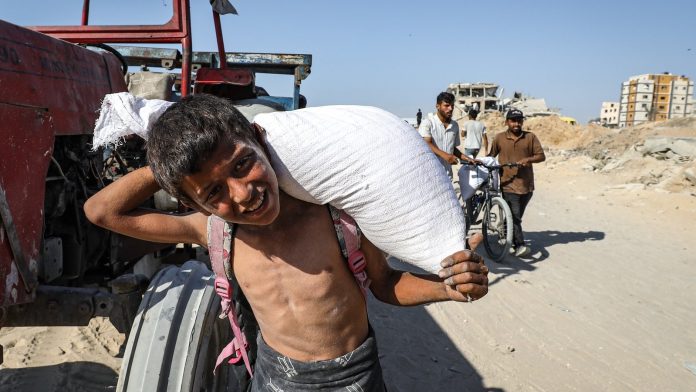
A Hostage Crisis Ignites Global Alarm: Inside the Gaza Conflict’s Humanitarian Abyss
The world watches with held breath as an ominous new chapter unfolds in the Gaza conflict—a grim spectacle of human suffering, desperation, and political brinkmanship. In an urgent call to action, the United Nations Security Council is set to convene an emergency meeting this Tuesday, summoned by Israel’s ambassador to address the stark and heart-wrenching reality confronting hostages held by Hamas in Gaza. The images emerging are not just distressing; they are a chilling testament to the harrowing human toll caught in the crossfire of one of the most protracted and divisive conflicts of our time.
Emaciated Faces, Shattered Lives
When Danny Danon, Israel’s ambassador to the UN, announced the special session, his words resonated with both urgency and sorrow. Videos broadcast over recent days have exposed the stark conditions of hostages held since the violent events of October 7, 2023, when Hamas launched a devastating incursion into Israeli territory. Among those shown are Rom Braslavski and Evyatar David—faces gaunt, bodies frail, spirits tested by deprivation. Their plight mirrors the larger, bleak landscape of Gaza’s humanitarian crisis, where the collapse of basic services has pushed millions to the brink of famine.
“Seeing those videos… it’s a piercing cry from the heart of captivity,” said Miriam Levy, a volunteer with a human rights organization in Tel Aviv. “These are not just hostages; they are symbols of how both war and politics devastate human dignity.”
Gaza’s Humanitarian Abyss: Siege, Starvation, and Survival
The humanitarian situation in Gaza, a strip of land just 365 square kilometers but home to over two million people, has been steadily unraveling. UN experts have issued stark warnings of a famine unfolding—a haunting descriptor that captures the desperation fueling daily life under siege. Israel has imposed stringent restrictions on the flow of aid, citing security concerns. However, humanitarian groups paint a picture of chaos: aid convoys are bottlenecked, redirected, or even looted in an environment teetering on the edge of breakdown.
“When you restrict essential goods and medicine, when supply lines are severed, you create a slow-moving disaster,” explained Dr. Leila Karim, a medical coordinator with an international relief organization currently monitoring the region. “The people here face impossible choices—should they risk their lives seeking dwindling aid? Or surrender to the hunger tightening its grasp?”
The plight of Gazans seeking food, water, and basic medical care is not just a statistic. It’s millions of individual stories—children whose eyes betray hunger, elders too weak to queue for assistance, families fractured by decades of blockade and conflict. The siege is not just a military tactic; it is a suffocating fog that entangles every corner of civilian life.
Negotiations Amidst Desperation: The Red Cross and the Question of Humanitarian Corridors
On the political frontline, Israeli Prime Minister Benjamin Netanyahu has turned to the International Committee of the Red Cross (ICRC), hoping to broker food delivery to the hostages being held. Hamas’s armed wing, the Al-Qassam Brigades, responded with a conditional offer: they will permit Red Cross access only if “humanitarian corridors”—safe passages for food and aid—are opened throughout Gaza.
This tug-of-war extends beyond mere logistics. It reveals the desperate and delicate interplay between warfare and humanitarianism. The Al-Qassam Brigades insist they do not “intentionally starve” the hostages, yet they refuse any special treatment for those captives amid what they call “the crime of starvation and siege” by Israel. The rhetoric is sharp, the stakes high, and the humanitarian window perilously narrow.
Mahmoud Al-Khalil, a Gaza-based journalist who has interviewed families affected by the siege, remarked, “This is a conflict not only of guns but of narratives. Each side portrays itself as the guardian of justice, while the people in the middle are starving, struggling to survive.”
The Human Faces Behind the Headlines
In Tel Aviv, grief-stricken families gather in the shadows of government rallies, clutching hope like a lifeline. The sight of Evyatar David flickering on screen, thin and frail, has reignited public demands for a ceasefire or at least a negotiated exchange. Their pain is raw, and the political discourse often feels painfully distant from these heartbreaks.
“When you watch those images,” said Rachel Abramson, mother of a young Israeli soldier, “you realize these are more than political pawns—they are fathers, brothers, husbands. Their suffering is a call for humanity above all.”
Looking Beyond Gaza: Reflections on War, Humanity, and Global Responsibility
This hostage crisis shines a stark light on the profound vulnerabilities endured by civilians in conflict zones worldwide. Gaza’s siege encapsulates enduring global questions: How do we safeguard human dignity amid strategic warfare? What responsibilities do international actors owe to those trapped in the crossfire? And, when the world watches atrocities unfold, how do we transform outrage into meaningful action?
The figures are sobering. According to the latest United Nations reports, nearly 80% of Gaza’s population depends on humanitarian aid. The blockade has decimated critical infrastructure—over 70% of medical supplies needed are either delayed or denied. In such a crucible, hostages are just one tragic facet of a broader human catastrophe.
As you read this, consider the human lives behind each grim statistic and headline. How do we respond, as a global community? What stories remain unheard, and whose voices should we amplify? In the uneasy balance between justice, security, and compassion, the fate of Gaza’s hostages presses us all for answers that transcend borders.
The UN Security Council’s emergency session this coming Tuesday will be more than just another diplomatic meeting. It will be a moment demanding more than words—a call to confront the human cost of conflict and to chart a path toward relief, peace, and dignity for those who suffer most.
What can we, as individuals and collectives, do when faced with such stark realities that unfold thousands of miles away yet touch the core of our shared humanity? The answer may be difficult, but the questions demand courage and compassion in equal measure.
Edited By Ali Musa
Axadle Times international–Monitoring.




